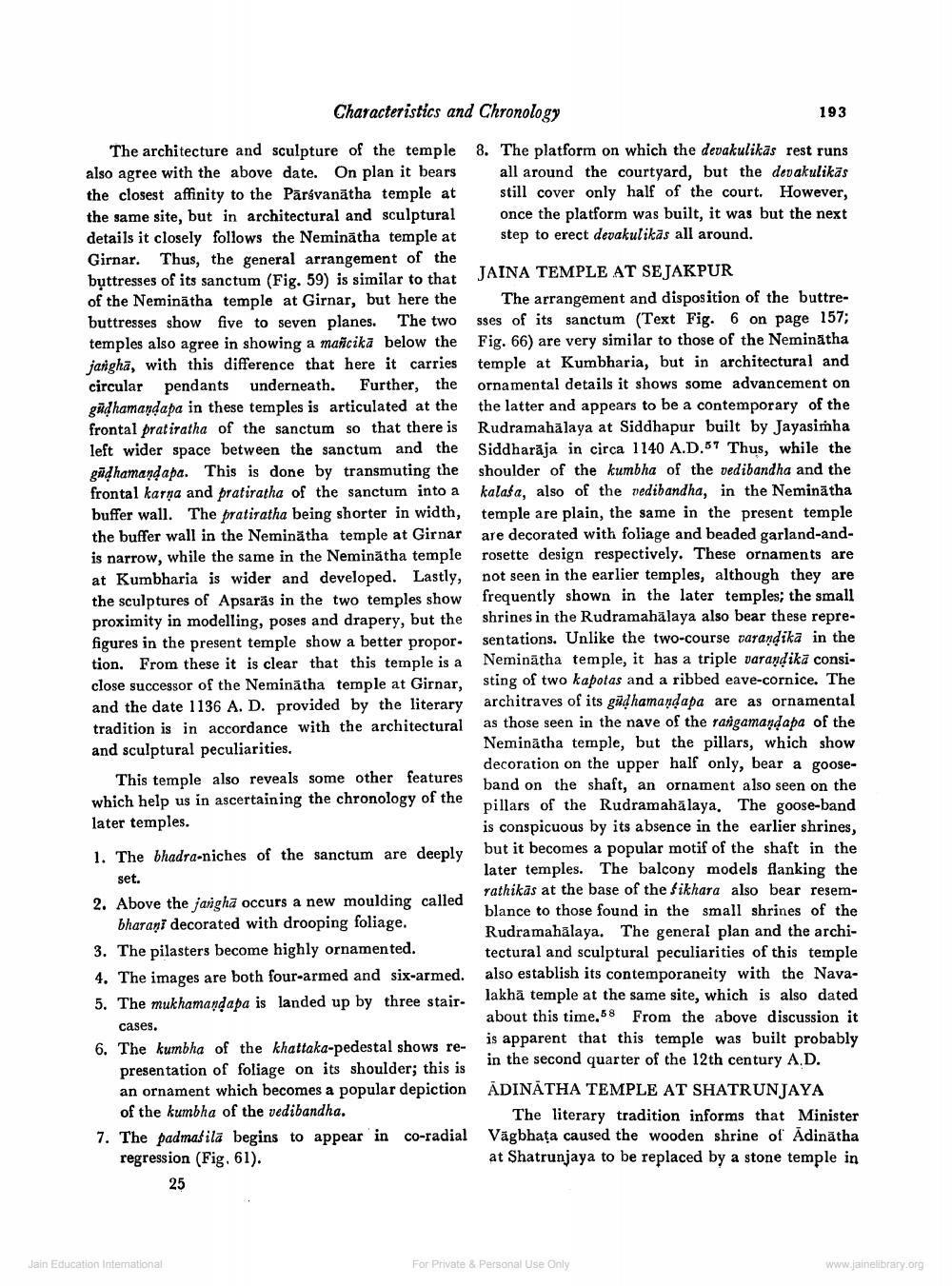________________
Characteristics and Chronology
193
The architecture and sculpture of the temple 8. The platform on which the devakulikās rest runs also agree with the above date. On plan it bears all around the courtyard, but the dev akulikās the closest affinity to the Pārsvanātha temple at still cover only half of the court. However, the same site, but in architectural and sculptural once the platform was built, it was but the next details it closely follows the Neminātha temple at step to erect devakulikas all around. Girnar. Thus, the general arrangement of the bụttresses of its sanctum (Fig. 59) is similar to that JAINA TEMPLE AT SEJAKPUR of the Neminātha temple at Girnar, but here the The arrangement and disposition of the buttrebuttresses show five to seven planes. The two sses of its sanctum (Text Fig. 6 on page 157; temples also agree in showing a mañcika below the Fig. 66) are very similar to those of the Neminātha jangha, with this difference that here it carries temple at Kumbharia, but in architectural and circular pendants underneath. Further, the ornamental details it shows some advancement on gūdhamandapa in these temples is articulated at the the latter and appears to be a contemporary of the frontal pratiratha of the sanctum so that there is Rudramahālaya at Siddhapur built by Jayasimha left wider space between the sanctum and the Siddharāja in circa 1140 A.D.57 Thus, while the gūdhamandapa. This is done by transmuting the shoulder of the kumbha of the vedibandha and the frontal karna and pratiratha of the sanctum into a kalaša, also of the vedibandha, in the Neminātha buffer wall. The pratiratha being shorter in width, temple are plain, the same in the present temple the buffer wall in the Neminatha temple at Girnar are decorated with foliage and beaded garland-andis narrow, while the same in the Neminätha temple rosette design respectively. These ornaments are at Kumbharia is wider and developed. Lastly, not seen in the earlier temples, although they are the sculptures of Apsaras in the two temples show frequently shown in the later temples; the small proximity in modelling, poses and drapery, but the shrines in the Rudramahalaya also bear these reprefigures in the present temple show a better propor. sentations. Unlike the two-course varandika in the tion. From these it is clear that this temple is a Neminātha temple, it has a triple varaydika consiclose successor of the Neminätha temple at Girnar, sting of two kapotas and a ribbed eave-cornice. The and the date 1136 A. D. provided by the literary architraves of its güdhamandapa are as ornamental tradition is in accordance with the architectural as those seen in the nave of the rangamandaba of the and sculptural peculiarities.
Neminātha temple, but the pillars, which show
decoration on the upper half only, bear a gooseThis temple also reveals some other features
band on the shaft, an ornament also seen on the which help us in ascertaining the chronology of the
pillars of the Rudramahālaya. The goose-band later temples.
is conspicuous by its absence in the earlier shrines, 1. The bhadra-niches of the sanctum are deeply
but it becomes a popular motif of the shaft in the
later temples. The balcony models flanking the set.
rathikās at the base of the Sikhara also bear resem2. Above the jargha occurs a new moulding called
blance to those found in the small shrines of the bharani decorated with drooping foliage.
Rudramahālaya. The general plan and the archi3. The pilasters become highly ornamented.
tectural and sculptural peculiarities of this temple 4. The images are both four-armed and six-armed. also establish its contemporaneity with the Nava5. The mukhamandapa is landed up by three stair.
lakha temple at the same site, which is also dated cases.
about this time, 58 From the above discussion it 6. The kumbha of the khattaka-pedestal shows re
is apparent that this temple was built probably presentation of foliage on its shoulder; this is
in the second quarter of the 12th century A.D. an ornament which becomes a popular depiction ADINĀTHA TEMPLE AT SHATRUNJAYA of the kumbha of the vedibandha.
The literary tradition informs that Minister 7. The padmašila begins to appear in co-radial Vägbhaţa caused the wooden shrine of Adinātha regression (Fig. 61).
at Shatrunjaya to be replaced by a stone temple in 25
Jain Education Interational
For Private & Personal Use Only
www.jainelibrary.org




